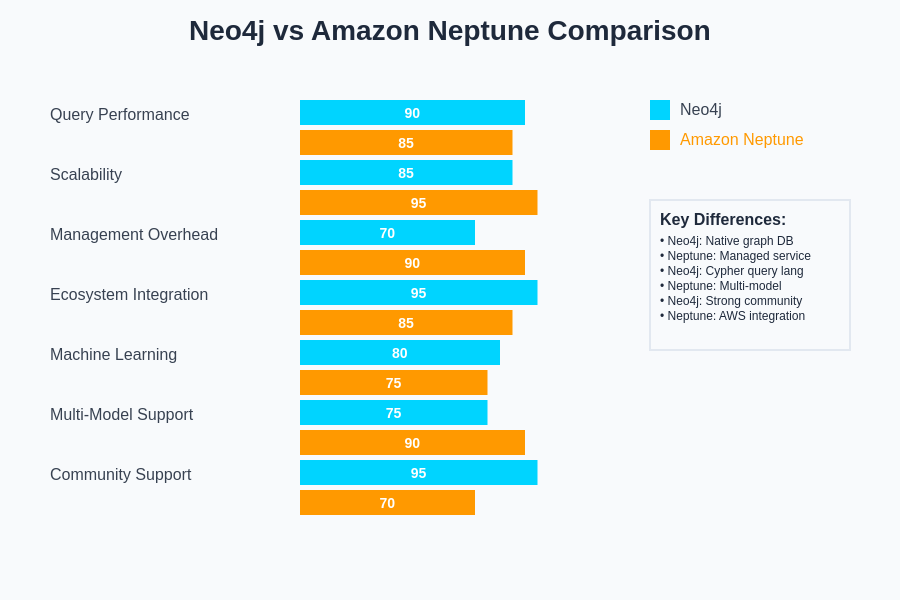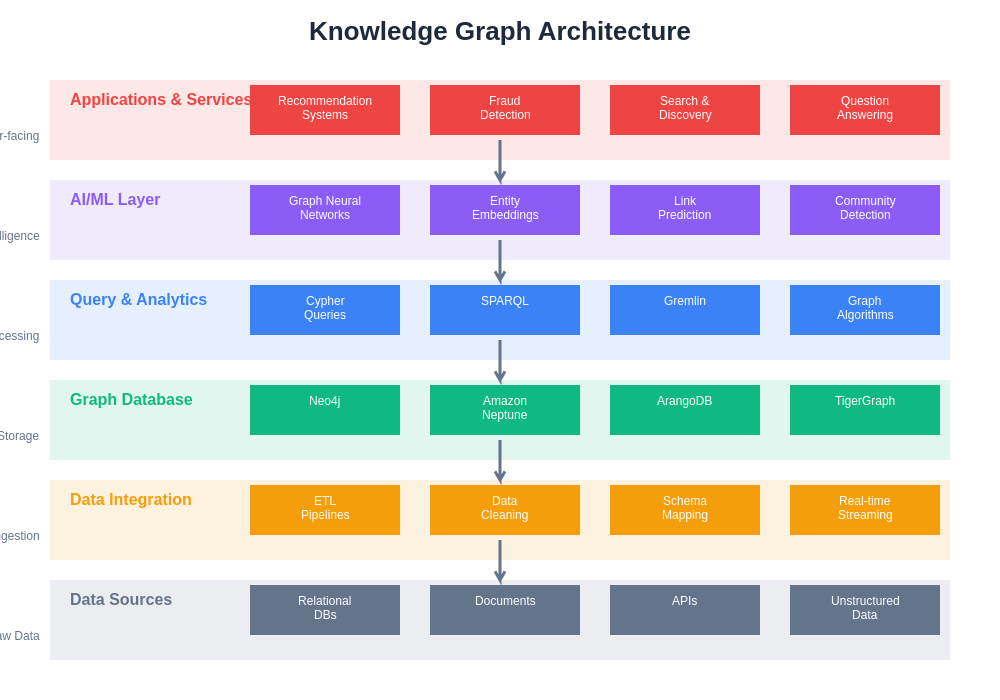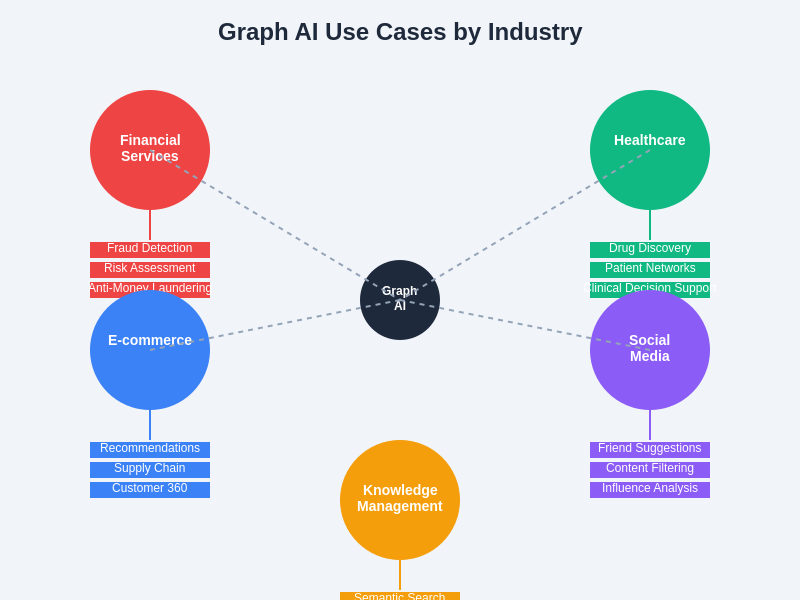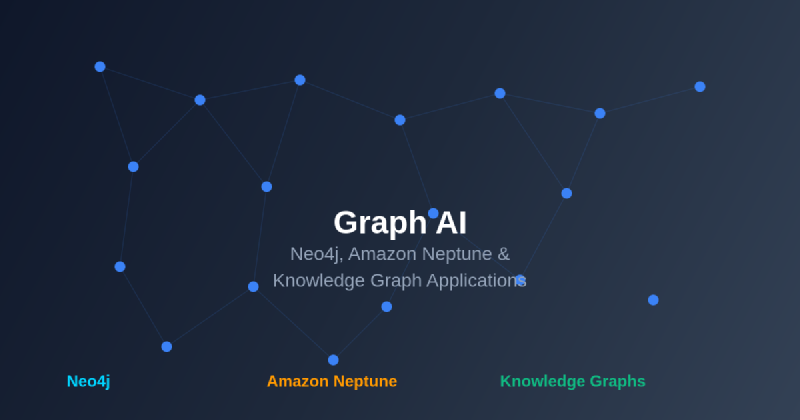The convergence of artificial intelligence and graph database technologies has created a revolutionary paradigm in data management and intelligent system design. Graph AI represents a transformative approach to understanding complex relationships within data, leveraging the inherent power of graph structures to model real-world connections and enabling sophisticated AI applications that can reason about interconnected information in ways previously impossible with traditional relational databases.
Modern enterprises generate vast amounts of interconnected data that traditional database systems struggle to represent efficiently. Graph databases like Neo4j and Amazon Neptune have emerged as essential infrastructure for organizations seeking to unlock the full potential of their relationship-rich data, while AI-powered knowledge graphs provide the intelligence layer that transforms raw connections into actionable insights and automated decision-making capabilities.
Discover the latest AI trends and graph technologies that are reshaping how organizations approach data modeling and intelligent system architecture. The intersection of graph computing and artificial intelligence represents one of the most promising frontiers in modern data science, enabling applications ranging from fraud detection and recommendation systems to complex knowledge management and automated reasoning platforms.
Understanding Graph AI and Knowledge Systems
Graph AI fundamentally reimagines how artificial intelligence systems interact with and understand data by embracing the natural graph structure inherent in most real-world information. Unlike traditional AI approaches that rely on tabular data or linear sequences, graph AI recognizes that the relationships between data points often contain as much valuable information as the data points themselves, leading to more nuanced and contextually aware intelligent systems.
The foundation of graph AI lies in its ability to represent complex, multi-dimensional relationships in a mathematically elegant and computationally efficient manner. Graph structures naturally model networks of entities and their connections, whether representing social networks, financial transactions, molecular structures, or knowledge domains. This representation enables AI algorithms to perform sophisticated reasoning tasks such as link prediction, community detection, path optimization, and anomaly identification with unprecedented accuracy and efficiency.
Knowledge graphs extend this concept by incorporating semantic meaning and ontological structures that enable AI systems to understand not just the existence of relationships but their semantic significance and contextual implications. This semantic layer transforms raw graph data into intelligent knowledge representations that can support complex reasoning, inference, and decision-making processes across diverse application domains.
Neo4j: The Pioneer of Graph Database Technology
Neo4j stands as the industry-leading native graph database platform, pioneering many of the fundamental concepts and technologies that define modern graph computing. Its property graph model provides an intuitive and flexible framework for representing complex data relationships while maintaining exceptional performance characteristics that scale to enterprise-level deployments with billions of nodes and relationships.
The Cypher query language developed by Neo4j has become the de facto standard for graph database interactions, providing a declarative syntax that naturally expresses graph traversal patterns and relationship queries. This linguistic approach to graph querying enables developers and data scientists to focus on the logic of their queries rather than the underlying algorithmic complexity, significantly accelerating the development of graph-based applications and analytical workflows.

The comparative analysis of Neo4j and Amazon Neptune reveals distinct strengths and optimization strategies for different deployment scenarios. While Neo4j excels in query performance and ecosystem maturity, Amazon Neptune provides superior managed service capabilities and seamless cloud integration, making the choice dependent on specific organizational requirements and technical constraints.
Neo4j’s comprehensive ecosystem includes advanced analytics capabilities, machine learning integration, and visualization tools that collectively provide a complete platform for graph AI development. The Graph Data Science library offers sophisticated algorithms for community detection, centrality analysis, similarity computation, and path finding, while the APOC (Awesome Procedures on Cypher) library extends the platform’s capabilities with hundreds of additional procedures and functions for data integration, transformation, and analysis.
Experience advanced AI capabilities with Claude for complex data modeling and graph algorithm development that requires sophisticated reasoning and analytical capabilities. The combination of human expertise and AI assistance accelerates the development of graph-based solutions while ensuring optimal architectural decisions and implementation strategies.
Amazon Neptune: Cloud-Native Graph Intelligence
Amazon Neptune represents AWS’s comprehensive approach to cloud-native graph database services, offering both property graph and RDF graph models within a fully managed, highly available infrastructure. Neptune’s dual model support enables organizations to leverage both the intuitive property graph approach for operational applications and the semantic web standards of RDF for knowledge representation and ontology management.
The platform’s serverless capabilities and automatic scaling features make it particularly attractive for organizations with variable workloads or those seeking to minimize operational overhead while maintaining enterprise-grade performance and reliability. Neptune’s integration with the broader AWS ecosystem provides seamless connectivity to machine learning services, data pipelines, and analytics tools, enabling sophisticated graph AI workflows that span multiple AWS services.
Neptune’s support for popular graph frameworks and query languages, including Gremlin, SPARQL, and openCypher, ensures compatibility with existing graph applications while providing flexibility in choosing the most appropriate query paradigm for specific use cases. This multi-language support facilitates migration from other graph systems and enables organizations to leverage existing expertise and code investments.
Knowledge Graph Architecture and Design Patterns
Effective knowledge graph implementation requires careful consideration of schema design, data modeling patterns, and architectural decisions that balance performance, flexibility, and semantic expressiveness. The design of knowledge graph schemas involves creating ontological structures that accurately represent domain knowledge while supporting efficient query patterns and reasoning operations.
Entity-relationship modeling in graph databases differs significantly from traditional relational approaches, requiring consideration of graph-specific concepts such as node labels, relationship types, property inheritance, and traversal patterns. Successful knowledge graph architectures often employ hierarchical modeling strategies, semantic layering, and modular design principles that enable incremental development and maintenance of complex knowledge domains.
Data provenance and versioning represent critical considerations in knowledge graph design, particularly for applications requiring audit trails, temporal reasoning, or collaborative knowledge management. Advanced knowledge graphs implement sophisticated versioning mechanisms that track the evolution of entities and relationships over time while maintaining referential integrity and supporting temporal queries that reason about historical states of the knowledge base.

The layered architecture of modern knowledge graph systems demonstrates the sophisticated integration required between data sources, processing layers, and intelligent applications. This architectural approach ensures scalable, maintainable systems that can evolve with changing requirements while maintaining consistent performance and reliability characteristics.
Advanced Graph Analytics and Machine Learning
The integration of machine learning algorithms with graph data structures has created powerful new capabilities for pattern recognition, predictive modeling, and automated decision making. Graph neural networks represent a particularly promising area where deep learning techniques are adapted to operate directly on graph structures, enabling sophisticated analysis of network topology, node classification, and link prediction tasks.
Community detection algorithms identify clusters and groups within large networks, revealing organizational structures, user segments, and functional modules that may not be apparent through traditional analytical approaches. These algorithms find applications in social network analysis, biological pathway discovery, fraud detection networks, and recommendation system optimization, providing insights that drive strategic business decisions and operational improvements.
Centrality measures and influence propagation models help identify key entities and understand information flow patterns within complex networks. These analytical techniques prove invaluable for identifying influential nodes, optimizing network structures, and predicting cascade effects in systems ranging from social media platforms to financial markets and supply chain networks.
Leverage Perplexity’s research capabilities for comprehensive analysis of graph algorithms and their applications across different industries and use cases. The combination of multiple AI research tools enables thorough exploration of graph analytics methodologies and their practical implementations.
Real-World Applications and Use Cases
Financial services organizations have embraced graph AI for fraud detection, risk assessment, and regulatory compliance applications that require analysis of complex transaction networks and relationship patterns. Graph-based fraud detection systems excel at identifying suspicious activity patterns, money laundering schemes, and coordinated attack networks that traditional rule-based systems often miss.
Healthcare and pharmaceutical industries leverage knowledge graphs for drug discovery, patient care optimization, and clinical decision support systems that integrate diverse data sources including medical literature, clinical trials, patient records, and molecular databases. These applications demonstrate graph AI’s ability to synthesize information from multiple domains and support evidence-based decision making in critical healthcare scenarios.
E-commerce and digital marketing platforms utilize graph technologies for personalized recommendation systems, customer segmentation, and supply chain optimization. Graph-based recommendation engines analyze user behavior patterns, product relationships, and social connections to provide more accurate and relevant product suggestions while identifying cross-selling and up-selling opportunities.
Social media and communication platforms rely heavily on graph databases for friend suggestion algorithms, content recommendation, community detection, and network analysis that enables targeted advertising and user engagement optimization. These applications process massive scales of interconnected data while maintaining real-time response requirements and supporting complex analytical queries.

The diverse applications of graph AI across industries demonstrate the technology’s versatility and transformative potential. From financial fraud detection to healthcare drug discovery, each sector leverages graph structures to solve domain-specific challenges while benefiting from shared algorithmic advances and technological innovations.
Performance Optimization and Scalability Strategies
Graph database performance optimization requires understanding of graph-specific concepts such as traversal complexity, index strategies, and query planning that differ significantly from traditional database optimization approaches. Effective indexing strategies for graph databases must consider both node properties and relationship patterns, often employing composite indexes that optimize specific traversal patterns and query types.
Query optimization in graph databases involves careful consideration of traversal direction, filtering strategies, and result set limitation techniques that minimize unnecessary graph exploration. Advanced query planning algorithms analyze graph topology and statistical distributions to determine optimal execution plans, while query caching mechanisms store frequently accessed subgraphs to improve response times.
Horizontal scaling strategies for graph databases present unique challenges related to graph partitioning, cross-partition traversals, and consistency maintenance. Modern graph database platforms implement sophisticated sharding algorithms that attempt to minimize cross-shard communications while maintaining balanced data distribution and supporting efficient query execution across distributed infrastructure.
Integration with Modern AI Frameworks
The integration of graph databases with popular machine learning frameworks such as TensorFlow, PyTorch, and scikit-learn has created powerful development environments for graph AI applications. These integrations enable data scientists and developers to leverage familiar ML tools while working with graph-structured data, accelerating the development of sophisticated analytical models and predictive systems.
Graph embedding techniques transform graph structures into vector representations that can be processed by traditional machine learning algorithms, enabling hybrid approaches that combine graph topology analysis with conventional ML techniques. Popular embedding methods such as Node2Vec, GraphSAGE, and Graph Attention Networks provide different strategies for capturing graph structural information in dense vector formats.
Real-time streaming integration enables graph databases to process continuous data streams and maintain up-to-date knowledge graphs that reflect current system states. This capability proves essential for applications such as fraud detection, network monitoring, and dynamic recommendation systems that require immediate response to changing conditions and emerging patterns.
Security and Privacy Considerations
Graph databases present unique security challenges related to data access control, relationship privacy, and inference prevention that require specialized security models and implementation strategies. Traditional role-based access control systems must be extended to consider graph-specific concepts such as path-based permissions, relationship visibility, and transitive access rights.
Privacy-preserving graph analytics techniques enable organizations to perform valuable analysis while protecting sensitive relationship information and individual privacy. Differential privacy, k-anonymity, and secure multi-party computation methods provide mathematical frameworks for balancing analytical utility with privacy protection requirements.
Data lineage and audit trail capabilities in graph systems support compliance with regulatory requirements while enabling forensic analysis of data access patterns and modification histories. These capabilities prove essential for organizations operating in regulated industries or those requiring detailed accountability for data usage and transformation processes.
Emerging Trends and Future Directions
The convergence of quantum computing and graph algorithms promises revolutionary advances in solving computationally complex graph problems that are intractable with classical computing approaches. Quantum graph algorithms for optimization, sampling, and search problems may enable breakthrough applications in areas such as drug discovery, financial modeling, and logistics optimization.
Federated graph learning represents an emerging paradigm that enables collaborative machine learning across distributed graph datasets while preserving data privacy and organizational boundaries. This approach enables organizations to benefit from collective intelligence while maintaining control over sensitive data and proprietary information.
Automated knowledge graph construction and maintenance technologies are evolving to reduce the manual effort required for knowledge graph development and evolution. Natural language processing, automated entity extraction, and relationship inference techniques enable semi-automated knowledge graph construction from unstructured text sources, while active learning approaches optimize human expert involvement in knowledge validation and refinement processes.
Implementation Best Practices and Architectural Guidelines
Successful graph AI implementations require careful planning of data ingestion strategies, schema evolution approaches, and operational monitoring frameworks that ensure system reliability and performance over time. Data quality management becomes particularly critical in graph systems where relationship accuracy and consistency directly impact analytical results and system behavior.
Development lifecycle management for graph AI projects involves specialized testing strategies, version control approaches, and deployment methodologies that account for the complex dependencies and interconnected nature of graph data. Continuous integration and deployment practices must accommodate graph-specific testing requirements such as relationship validation, traversal performance testing, and semantic consistency verification.
Monitoring and observability frameworks for graph systems require specialized metrics and alerting strategies that track graph-specific performance indicators such as traversal latency, index utilization, and query complexity patterns. These monitoring approaches enable proactive identification of performance issues and capacity planning for growing graph datasets and increasing query complexity.
Conclusion: The Future of Intelligent Data Systems
Graph AI represents a fundamental shift toward more natural and effective approaches to modeling and reasoning about complex, interconnected data. The combination of sophisticated graph database platforms like Neo4j and Amazon Neptune with advanced AI techniques creates unprecedented opportunities for building intelligent systems that understand and leverage the rich relationship structures inherent in real-world data.
The continued evolution of graph AI technologies promises to unlock new possibilities in areas ranging from scientific discovery and healthcare innovation to financial risk management and social network analysis. Organizations that embrace these technologies and develop expertise in graph-based thinking will be positioned to create competitive advantages through more sophisticated data analysis, better decision-making capabilities, and innovative applications that were previously impossible with traditional data management approaches.
The future of data-driven applications lies in systems that can understand not just individual data points but the complex web of relationships that connect them, creating intelligent applications that reason about interconnected information with human-like sophistication while operating at machine-scale efficiency and accuracy.
Disclaimer
This article is for informational purposes only and does not constitute professional advice. The views expressed are based on current understanding of graph database technologies and AI applications. Readers should conduct their own research and consider their specific requirements when implementing graph AI solutions. The effectiveness and suitability of different graph database platforms may vary depending on specific use cases, data characteristics, and organizational requirements.
